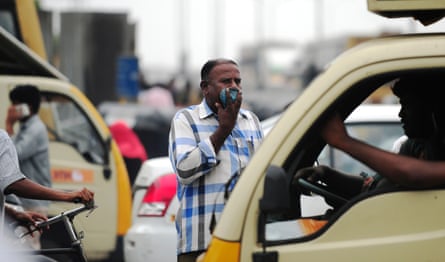A groundbreaking study from India suggests that air pollution increases the likelihood of developing type 2 diabetes.
A recent study in India has revealed that breathing in polluted air can heighten the chances of developing type 2 diabetes. The research, which took place in Delhi and Chennai, discovered a correlation between inhaling high levels of PM2.5 particles and elevated blood sugar levels, ultimately leading to an increased incidence of type 2 diabetes.
Breathing in PM2.5 particles, which are 30 times smaller than a strand of hair, can lead to the development of respiratory and cardiovascular illnesses as they can enter the bloodstream.
Ongoing research in India, which began in 2010, is investigating chronic illnesses and their connection to exposure to PM2.5 pollution. This is the first study to specifically examine the relationship between ambient PM2.5 and type 2 diabetes in India, a country with high levels of air pollution.
³ in 2019
The average yearly PM2.5 levels in Delhi for 2019 were between 82 and 100 micrograms per cubic meter.33
In Chennai, the air quality was measured at 30-40 micrograms per cubic meter.33
The research found that frequently, the levels of air pollution in India exceed the recommended limit set by the World Health Organization, which is 5 micrograms per cubic meter. India’s own national air quality regulations allow for a limit of 40 micrograms per cubic meter.3.
India also has a significant prevalence of non-communicable diseases such as diabetes, hypertension, and heart disease. Approximately 11.4% of the population, which is equivalent to 101 million people, are currently living with diabetes, and an additional 136 million individuals are considered pre-diabetic. These findings were published in a paper by the Lancet in June. In comparison, the average prevalence of diabetes in the European Union was 6.2% in 2019 and 8.6% in the UK in 2016.
According to The Lancet study, the prevalence of diabetes in India is higher than previously estimated, with a greater number of individuals diagnosed in urban areas compared to rural areas.

The BMJ study tracked a group of 12,000 individuals in Delhi and Chennai over a period of 7 years (2010-2017) and regularly monitored their blood sugar levels. By utilizing satellite data and air pollution models, the researchers were able to assess the level of air pollution in the area where each participant lived during this time frame.
3 increase in PM2.5, the risk of diabetes increased by 15%.
A study revealed that being exposed to PM2.5 for one month resulted in higher levels of blood sugar, while prolonged exposure of one year or more was linked to a heightened risk of developing diabetes. The risk of diabetes was found to increase by 15% for every 10μg/m3 rise in PM2.5.3
The rise in the average yearly PM2.5 level in the two cities was associated with a 22% increase in the risk of diabetes.
According to Siddhartha Mandal, the lead researcher at the Centre for Chronic Disease Control in Delhi, Indians have a higher risk of diabetes due to their low BMI and high proportion of fat.
He stated that the combination of air pollution and changes in lifestyle over the last 20 to 30 years has contributed to the growing prevalence of diabetes, an environmental issue.
Dr. V Mohan, chairman of the Madras Diabetes Research Foundation and co-author of the paper, stated that previously, it was believed that diet, obesity, and physical activity were contributing factors to the higher rates of diabetes in urban Indians compared to rural Indians. However, this study has revealed pollution as a new cause of diabetes, which is a significant finding.

3)
A separate investigation on the identical group in Delhi discovered that the typical yearly exposure to PM2.5 in Delhi was 92 micrograms per cubic meter. 3
This resulted in a rise in blood pressure levels and an increased chance of developing hypertension.
Mandal stated that a combination of studies indicates that the elevated levels of PM2.5 in Indian urban areas can result in health issues such as diabetes and hypertension, which may contribute to the development of atherosclerosis, heart attacks, and heart failures.
According to Dr. Dorairaj Prabhakaran, a cardiologist and executive director of the Centre for Chronic Disease Control, PM2.5 is made up of sulfates, nitrates, heavy metals, and black carbon. These substances have the potential to harm the lining of blood vessels and stiffen the arteries, resulting in increased blood pressure. Additionally, they can accumulate in fat cells, leading to inflammation and direct harm to the heart muscle.
PM2.5 serves as an endocrine disruptor, hindering the body’s production and effectiveness of insulin.
According to Mohan, there has been an increase in hypothyroidism, polycystic ovarian syndrome (PCOS), and gestational diabetes in urban India. This study suggests that pollution may contribute to these health issues by disrupting the endocrine system responsible for hormone production in the body.

The scientists are currently studying the effects of pollution on the levels of cholesterol and vitamin D in the body and how it affects various aspects of an individual’s life, such as birth weight, the health of pregnant women, insulin resistance in adolescents, and the likelihood of developing Parkinson’s and Alzheimer’s disease.
According to Prabhakaran, although the results are concerning, the study provides optimism for scientists that reducing pollution could potentially reduce the impact of diabetes and other non-communicable diseases.
Several public policy efforts have yielded positive outcomes. Following public concern regarding air pollution in 2016, both the central and Delhi governments implemented measures such as prohibiting older diesel vehicles, restricting construction, constructing bypass highways, and prohibiting crop burning. Reports indicate a 22% decrease in PM2.5 levels from 2016 to 2021.
Prabhakaran stated that this is a small yet appreciated decrease. It is crucial for similar actions to be implemented to suit the specific circumstances in various areas throughout the nation.
Source: theguardian.com

